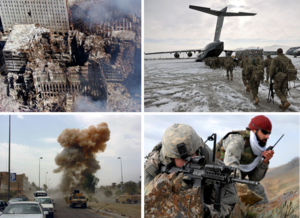War on Terrorism
| War on terror | |||||||
|---|---|---|---|---|---|---|---|
Photographs, clockwise from top left: Aftermath of the September 11 attacks; U.S. servicemen boarding an aircraft at Bagram Air Base, Afghanistan; a U.S. soldier and Afghan interpreter in Zabul Province, Afghanistan; explosion of an Iraqi car bomb in Baghdad. Map: Countries with major military operations of the war on terror. | |||||||
| |||||||
| Belligerents | |||||||
| Main countries: |
Main opponents:
| ||||||
| Commanders and leaders | |||||||
|
|
| ||||||
| Casualties and losses | |||||||
|
4.5–4.6 million+ people killed[a] (937,000+ direct deaths, 3.6–3.7 million indirect deaths)[b] At least 38 million people displaced[c] | |||||||
The Global War on Terrorism, or War on Terror, is a campaign that the United States and some of its allies started in September 2001 to remove terrorist groups and to punish the states that sponsor terrorism. It replaced the later War in Afghanistan and Iraq War. United States President George W. Bush argued that the countries like North Korea, Cuba, Iran, Iraq, Syria, and Libya (also known as the Axis of Evil) were a direct threat to the United States and its allies. The term was typically used with a particular focus on militant Islamists and al-Qaeda.
The Administration of former U.S. President Barack Obama used the term Overseas Contingency Operation.[2]
Notes
References
- ↑ "Video: Pres. Bush Declares War on Terror". ABC News archives. September 15, 2001.
- ↑ Obama Scraps 'Global War on Terror' for 'Overseas Contingency Operation'.
- ↑
- "Human Cost of Post-9/11 Wars: Direct War Deaths in Major War Zones, Afghanistan & Pakistan (Oct. 2001 – Aug. 2021); Iraq (March 2003 – Aug. 2021); Syria (Sept. 2014 – May 2021); Yemen (Oct. 2002–Aug. 2021) and Other Post-9/11 War Zones". The Costs of War. Retrieved 10 September 2021.
- Berger, Miriam (15 May 2023). "Post-9/11 wars have contributed to some 4.5 million deaths, report suggests". The Washington Post. Archived from the original on 29 May 2023.
- Savell, Stephanie (15 May 2023). "How Death Outlives War: The Reverberating Impact of the Post-9/11 Wars on Human Health" (PDF). Costs of War. Watson Institute of International & Public Affairs. Archived from the original (PDF) on 9 June 2023.
- ↑
- "Human Cost of Post-9/11 Wars: Direct War Deaths in Major War Zones, Afghanistan & Pakistan (Oct. 2001 – Aug. 2021); Iraq (March 2003 – Aug. 2021); Syria (Sept. 2014 – May 2021); Yemen (Oct. 2002–Aug. 2021) and Other Post-9/11 War Zones". The Costs of War. Retrieved 10 September 2021.
- Berger, Miriam (15 May 2023). "Post-9/11 wars have contributed to some 4.5 million deaths, report suggests". The Washington Post. Archived from the original on 29 May 2023.
- Savell, Stephanie (15 May 2023). "How Death Outlives War: The Reverberating Impact of the Post-9/11 Wars on Human Health" (PDF). Costs of War. Watson Institute of International & Public Affairs. Archived from the original (PDF) on 9 June 2023.
- ↑
- "Human Cost of Post-9/11 Wars: Direct War Deaths in Major War Zones, Afghanistan & Pakistan (Oct. 2001 – Aug. 2021); Iraq (March 2003 – Aug. 2021); Syria (Sept. 2014 – May 2021); Yemen (Oct. 2002–Aug. 2021) and Other Post-9/11 War Zones". The Costs of War. Retrieved 10 September 2021.
- Berger, Miriam (15 May 2023). "Post-9/11 wars have contributed to some 4.5 million deaths, report suggests". The Washington Post. Archived from the original on 29 May 2023.
- Savell, Stephanie (15 May 2023). "How Death Outlives War: The Reverberating Impact of the Post-9/11 Wars on Human Health" (PDF). Costs of War. Watson Institute of International & Public Affairs. Archived from the original (PDF) on 9 June 2023.
Other websites
 Media related to War on terror at Wikimedia Commons
Media related to War on terror at Wikimedia Commons

